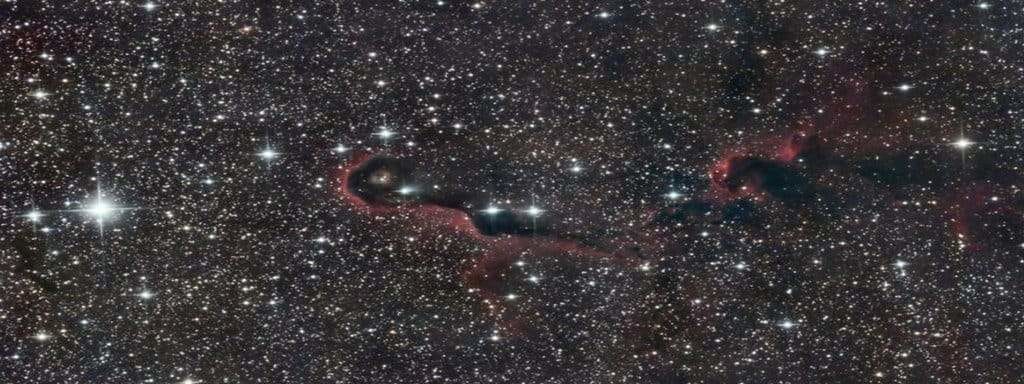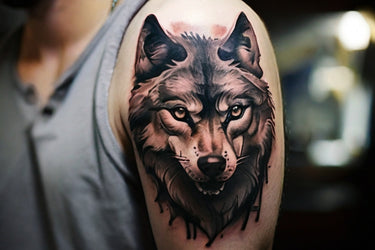IS THERE A WOLF CONSTELLATION?
Are you, like the moonlit wolf, lost in the stars?
Then gaze through his eyes, direct them to the nocturnal heavens and uncover gems of illumination.
Let's go on a journey through history and cosmic immensity, to discover the thousand astronomical wonders that our Constellation abounds in.
Let's dive into the heart of the Wolf Constellation which is dotted with Blue Giants, Triple and Double Stars, a Spiral Star, an Exoplanet, Gas Giants in formation, Proto-Stars, Obscure or Bipolar Nebulae, several Galaxies, Supermassive Black Holes, Open Clusters and Supernovas.
This article offers you the most exhaustive compilation of data on the web on this subject,
in addition to numerous pictures and documentary films.
As always, hold on firmly.
Here we go!
1/ History and Mythology of the Wolf Constellation

A) The Egyptians at the origin of the Wolf Constellation?
Despite our Constellation being situated in the Southern Hemisphere, it becomes visible at our latitudes during the equinoxes.
The oldest name given to this group of stars is Wolf, which dates back to Ancient Egypt.
When Osiris returned from the Underworld to help Horus and Isis against Typhon, he took the form of a wolf.
Hence, the emergence of the wolf constellation on the skyline signifies both the rebirth of Osiris and the heralding of spring.
The article discusses "Wolf Mythology" and mentions OUPOUAOUT, a god with a wolf head. OUPOUAOUT rules the West, where the sun sets. This region is believed to lead to the afterlife.
The Wolf Constellation represents light triumphing over darkness in spring. It guides souls to the afterlife in autumn. The constellation disappears below the horizon during this time.

B) First stellar census in Ancient Greece:
Later, in the 1st century AD, the Greek Claudius Ptolemy undertook to map the 48 constellations in his Almagest.
He took the figure of the Wolf from the Egyptians to identify this celestial region.
The Greek myths that still prevail today associate the Wolf with the Centaur.
In ancient stories, a Centaur named Chiron sacrifices a dog to the Altar constellation.

C) Historical Observation of a Cosmic Phenomenon:
Significantly later, during 1006, a star that outshone Venus emerged in the heavens.
It was one of the stars of the Wolf Constellation that exploded into a Supernova.
Its brightness equal to a quarter of the moon made it visible even during the day.
It happened everywhere around the world for 2 years!
Many texts from different cultures talk about seeing a new star in the sky.
There were four supernovae visible in the past thousand years, in 1004, 1006, 1054, and 1572.

-SUPER NOVÆ 1006:
This is likely to be the only star known since ancient times to have been able to form shadows on the Earth's surface.
According to researchers from the University of Barcelona and the Institute of Astrophysics of the Canary Islands, SN 1006 is the result of the "collision of two white dwarf stars".
The two stars literally pulverized each other, generating a plume still visible today.
Its distance is estimated at about 7,100 light years. Scientists have extensively studied this phenomenon using X-rays and gamma-rays. They want to understand how cosmic rays accelerate.

D) The Wolf in the Amerindian Astrological Sign:
The Amerindian peoples have developed their own zodiac.
The Wolf sign is between February 19th and March 20th, matching Pisces in the West.
It precedes the advent of Spring and expresses the ambivalence of Nature.
Its wild and noble temperament corresponds to the strong values of freedom and bravery that animate the Amerindian people. His double-edged nature between ferocity and loyalty invites the one who invokes the Wolf to make his choices, to be self-determined in life.
2/ The Great Interstellar Structures of the Wolf Constellation
A) Galaxy and Supermassive Black Hole in the Mouth of the Wolf:

-NGC 5643:
This galaxy is located 55 million light years from Earth in the Constellation of Lupus (the wolf)
This galaxy is called "Seyfert" and has an extremely shimmering center.
This accretion of light is due to all the matter that falls inside the Supermassive Black Hole hidden in its center.
The agglomeration of intergalactic dust forms clouds that obscure the star.
Seen from the Earth, the disk appears on its edge, which makes its observation less easy.
Thanks to data from ALMA and MUSE telescopes, scientists now understand how it works better.
This advanced technology has highlighted the two impressive jets of ionized gas expelled at the two poles of the Singularity (the Black Hole).
Two energetic columns expelled at a speed approaching that of light over huge distances!
Recently the appearance of a Supernova (SN2017cbv) has illuminated the Spiral Galaxy.
Amateur astronomers located in the northern tropic will be able to fully enjoy the spectacle offered by this cataclysmic explosion.
NGC 5643 and SN2017cbv is located between the stars Eta Centauri (2.3m) and Tau1 du Loup (4.50m).
The spiral galaxy is precisely located at 1°30'NE of the latter, at the following coordinates: 14h33m49s and -44°14'41"
B) A Dark Nebula in the Wolf's Fur:

-BARNARD 228: THE BLACK WOLF NEBULA
This dark nebula is 500 light-years away from Earth. It looks like a wolf in front of a shiny background of stars. It is a big dark patch in space.
Otherwise known as the Absorption Nebula, it is a colossal cloud of interstellar dust. However, if we look at it at infrared wavelengths, it is incredibly active and full of life. With a very irregular shape and an average density of 100 to 300 molecules per cubic centimeter, this giant cloud is several million times more massive than the Sun.
A true reservoir of galactic matter, it has an internal magnetic field that prevents it from collapsing under its own gravity. This type of phenomenon makes up a large part of the mass of galaxies and plays an important role in their dynamics. Their considerable gravitational attraction often attracts the orbit of stars that approach them.
The internal regions of dark nebulae are the seat of creative events:
The collapse of molecular gases leads to a series of chain reactions up to thermonuclear fusions.
It is in the heart of these dark depths that the protostars are formed!
We will come back to this...
C) A Bipolar Nebula in the eye of the Wolf:

-IC4406: THE NEBULA OF THE RETINA:
Is both a Planetary and Bipolar Nebula.
A small telescope allows to see it surrounded like a goddess by several galaxies.
Spread out like the iridescent wings of a butterfly, this mirror-like structure is the symmetric ejecta of a dying star. The dispersed gases still radiate light from the central star.
Ionized oxygen radiates a bluish glow, hydrogen vibrates in the greens and nitrogen in the reds. A cosmic web, infinitely large and bright, but similar to the colored tendrils of an iris.
D) An Open Cluster in the heart of the Wolf:

-NGC 5824 :
Is an Open Globular Cluster located in the Wolf Constellation, on its western border with the Centaur .
Although quite condensed, it can still be observed with small telescopes.
Larger apertures will be needed to see into its center.
In astronomy, an open cluster is a group of stars with 100 to 1000 bodies of the same age and linked together.
The only notable differences between the stars in this type of cluster are their masses.
This cluster is dominated by its Blue Giants which live for a short time (on the scale of the Universe), because they burn their fuel very quickly which also makes them very bright.
Moreover, the youth of the cluster is calculated by the number of its Blue Stars.
The latter, initially very close, tend to move away according to the external disturbances. Influenced by the surrounding tidal effects, the cluster opens, and its components disperse to form streams of errant stars.
After about a billion years, the cluster will have completely disappeared, its stars having been dispersed by the rotation of the Milky Way, exactly as for the cluster to which our solar system belonged.
3/ The Astral Jewels of the Wolf Constellation
A) Stars like eyes in the night:

-ALPHA LUPI:
Is the most sparkling star of the Lupus Constellation.
Its brilliance makes it easily visible to the naked eye, even from very light polluted places.
This Blue Giant is located at a distance of about 460 light years from Earth.
It is about 10 times the mass of the Sun and radiates 25,000 times its brightness.
Its hyperactivity makes it the closest candidate for explosion.
Perhaps we will see it change into a Supernova!

-BETA LUPI:
Is the second brightest star in the Wolf Constellation.
Of magnitude 3, it is located 525 light-years from the planet Earth.
The Chinese named it: "Kekouan", which means "Cavalry Officer".

-GAMMA LUPI:
It is actually a Triple Star.
Gamma Lupi, Gamma Lupi A and Gamma Lupi B.
These two rotate around each other, and this pair takes 190 years to go around the first one which is almost 9 times the size of our Sun.
They evolve at a distance of about 565 light-years from the Earth.
The Greeks named it "Thusia", which means "the Sacrifice", or even "Thusia Theirou", which means "the animal sacrifice".

-EPSILON LUPI:
Is actually a Binary Star of the Wolf Constellation.
These two blue-white subgiants revolve around each other at a distance of about 500 light years from Earth.
Recent research has shown that in addition to their own magnetic fields, this duo generates another encompassing magnetic field.
The luminosity of this system is equivalent to 4100 times that of the Sun and its mass is 8 times greater.

-SAO 206462:
Is a very young star with two perfectly drawn spiral arms.
It is located at about 460 light-years from our system.
These spiral arms seem to indicate the presence of planets inside the disk of gas surrounding the whole.
The total diameter of this system is almost twice the orbit of Pluto.
B) An Exoplanet shows us the end of its tail!

-GQ LUPI A & B:
Is one of the first exoplanets to be discovered by direct imaging.
It rotates at 100 Astronomical Units (1AU = distance Earth-Sun) from its sun (a Brown Dwarf) which gives it an orbital period of 1200 Earth years!
Current calculations estimate that it is between 2 times and 36 times the mass of Jupiter.
For the moment the models do not allow to identify with certainty the exact nature of this strange object.
C) Nurseries of Suns and Giants:

-LET US RETURN TO THE BLACK WOLF NEBULA.
Perhaps we could call it the Black Wolf Nebula.
This majestic cosmic silhouette is a matrix about ten light-years long, capable of generating several litters of baby stars.
In the bowels of the "beast", and this for only a few hundred thousand years, two protostars are still in gestation.
With simple binoculars and in clear weather, you will be able to admire their bluish halos.
This fascinating spectacle for the amateur eye is also a source of crucial knowledge about star formation. Their genesis is not yet complete, because their temperature is not quite sufficient for the nuclear reactions to start in their cores.
The cubs will remain for a while in the bosom of their mother.
To give you an idea of the fertility of this Black Nebula, you should know that during its life it will give birth to several thousand other stars.

-HD 142527:
Still in the Wolf Constellation, located 646 light-years from us, astrophysicists have detected a very young star.
About 1 million years old, its orbit is saturated with dust and gas in accretion.
Hidden in the middle of this protoplanetary disk, researchers have discerned the gravitational signatures of two gas giants.
Their calculations indicate vortices and vortex structures typical of the formation of such bodies.
These interferences of hyper massive flows let us guess that these two giants exceed several times the proportions of Jupiter.
We will have to wait a little longer to see the result of this sidereal dynamo!

The Dream of the Wolf
We have just explored the most fascinating places of the Wolf Constellation.
But let's not go back down right away...
Let's stay a little more weightless, let us drift for a moment in this shimmering canvas.
Like its celestial image, Loup Constellation is rich in nuggets and little gems.
Continue the adventure by taking with you everywhere a corner of the universe and the universe of the wolf.
TRAVEL AGAIN THROUGH OUR COLORFUL GALLERIES

Because today the STAR is you!











